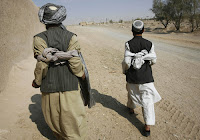|
|
|---|
Saturday, October 2, 2010
Afghanistan War and the future steps
-
It may lose the war in Afghanistan. Pakistan teeters. Today's Post says that the Obama administration now frets about that nation's stability. Michael Mullen, Obama's top military adviser, on Wednesday dismissed reports of infighting within the Obama adminstration over Afghanistan war strategy. ...
What is the human cost of the war in Afghanistan for British forces? As British troop deaths exceed 300, these are the latest figures - including new .
Risks in 2010: The Endless Afghan War
NATO’s vision of bringing peace and stability to Afghanistan remains exactly that—a vision. Nine years after the U.S.–led operation began, the conflict still ranks among the biggest global risks in 2010.
 | Dying Hopes For PeaceSupporters of religious party Jamiat-e-Ulema-e-Islam burn a U.S. flag to protest against the conviction of a Pakistani woman by a U.S. court in February 4, 2010. Afghanistan and its' neighboring states still count as major risks in 2010. (Photo: Reuters) |
Dying Hopes For Peace
Supporters of religious party Jamiat-e-Ulema-e-Islam burn a U.S. flag to protest against the conviction of a Pakistani woman by a U.S. court in February 4, 2010. Afghanistan and its' neighboring states still count as major risks in 2010. (Photo: Reuters)
U.S. President
Afghanistan’s presidential election was accompanied by poor security and undermined by ballot fraud and open intimidation. Faith in
The attempt to impose democracy has resulted in a lawless limbo, boosting corruption and the opium trade. Although the interim administration banned poppy growing in 2002, Afghanistan still supplied 90 percent of the world’s opiates in 2009.
The country’s agonies are compounded by rapid population growth. Afghanistan’s population—currently about 28 million—is expected to increase by over 30 percent in less than ten years. Many will be young men with little hope of getting a job: a recipe for further radicalization.
The World Bank has warned that population growth, along with climate change, is already causing water stress and could lead to outright scarcity.
Economic and social development, not military power, will most likely improve the situation. But after decades of conflict, the Afghan state lacks the laws, the institutions, and the infrastructure for a growing economy.
President Barack Obama is letting down his troops and seems not to have the commitment and 'X-factor' to win the war in Afghanistan, Bob Woodward has told .
The newest way General Petraeus plans to measure success in the war in Afghanistan reminded me of what the government did when its campaign to persuade.
The Soviet War in Afghanistan was an almost ten-year conflict involving the Soviet Union, supporting the Marxist-Leninist government of the Democratic .
Labels: afgan war picture, news and vedio also.
0 Comments:
Subscribe to:
Post Comments (Atom)



























